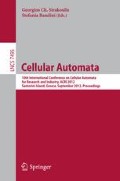Abstract
The paper characterizes a special class of Cellular Automaton (CA) called Two Predecessor Single Attractor CA (TPSA-CA). We show that the transition graphs of the TPSA-CA can be used to realize pseudo-random regular graphs with good expansion properties. The elegance of the scheme lies in the fact that the storage required to capture the graph is O(log N), where N is the total number of vertices in the graph.
Access this chapter
Tax calculation will be finalised at checkout
Purchases are for personal use only
Preview
Unable to display preview. Download preview PDF.
References
Goldreich, O.: Candidate One-Way Functions Based on Expander Graphs. Cryptology ePrint Archive, Report 2000/063 (2000)
Charles, D.X., Lauter, K.E., Goren, E.Z.: Cryptographic Hash Functions from Expander Graphs. Journal of Cryptology (2007)
Chaudhuri, P.P., Chowdhury, D.R., Nandi, S., Chattopadhyay, S.: Additive Cellular Automata Theory and its Application, vol. 1. IEEE Computer Society Press (1997)
Linial, N., Wigderson, A.: Expander graphs and their applications, (2003), http://www.math.ias.edu/boaz/ExpanderCourse/
Lubotzky, A., Phillips, R., Sarnak, P.: Ramanujan graphs. Combinatorica 8(3), 261–277 (1988)
Margulis, G.A.: Explicit constructions of expanders. Problemy Peredači Informacii 9(4), 71–80 (1973)
Margulis, G.A.: Explicit group-theoretic constructions of combinatorial schemes and their applications in the construction of expanders and concentrators. Problemy Peredachi Informatsii 24(1), 51–60 (1988)
Panjwani, S.K.: An Experimental Evaluation of Goldreich’s One-Way Function, Cryptology ePrint Archive, Report 2000/063 (2001)
Alon, N.: Eigen Values, Geometric Expanders, Sorting in Rounds and Ramsey Theorem. Combinatorica 6, 207–219 (1986)
Author information
Authors and Affiliations
Editor information
Editors and Affiliations
Rights and permissions
Copyright information
© 2012 Springer-Verlag Berlin Heidelberg
About this paper
Cite this paper
Mukhopadhyay, D. (2012). Generating Expander Graphs Using Cellular Automata. In: Sirakoulis, G.C., Bandini, S. (eds) Cellular Automata. ACRI 2012. Lecture Notes in Computer Science, vol 7495. Springer, Berlin, Heidelberg. https://doi.org/10.1007/978-3-642-33350-7_6
Download citation
DOI: https://doi.org/10.1007/978-3-642-33350-7_6
Publisher Name: Springer, Berlin, Heidelberg
Print ISBN: 978-3-642-33349-1
Online ISBN: 978-3-642-33350-7
eBook Packages: Computer ScienceComputer Science (R0)

